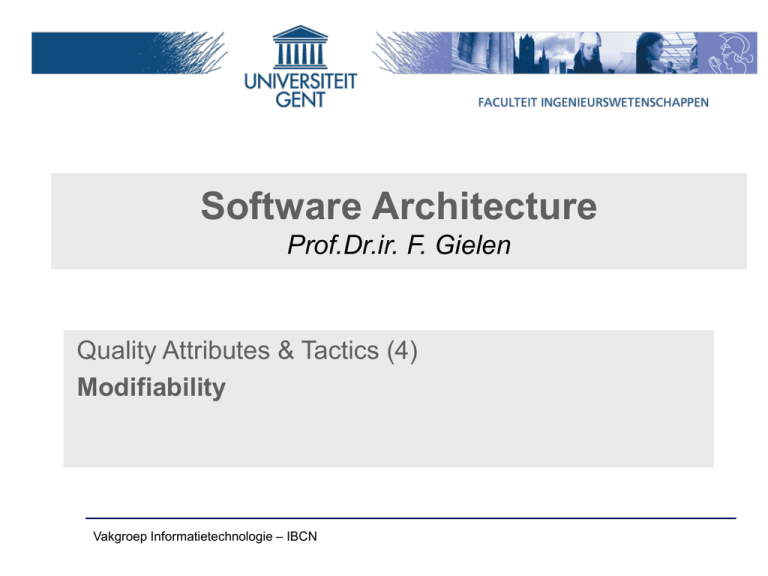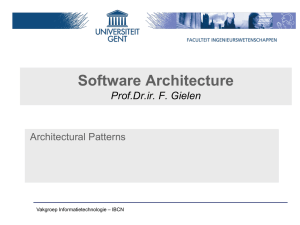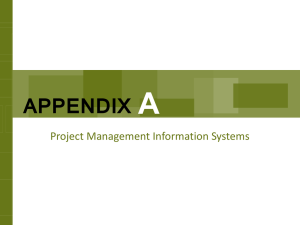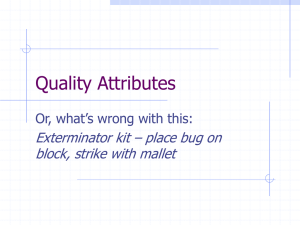SA_007_Modifiability
advertisement

Software Architecture Prof.Dr.ir. F. Gielen Quality Attributes & Tactics (4) Modifiability Vakgroep Informatietechnologie – IBCN Modifiability Modifiability is about the cost of changes. What Functions, Platform, Environment. Data, data representation System Qualities (performance, throughput,…) When is the change required ? Development time, build time, ..runtime Who can change ? will implement the change ? Software engineers ? Users ? Administrators ? Vakgroep Informatietechnologie – Onderzoeksgroep IBCN p. 2 Modifiability Scenario “A developer wants to change the UI code at design time; the modification is made without side effects in 3 hours.” Vakgroep Informatietechnologie – Onderzoeksgroep IBCN p. 3 Modifiability Tactics Change Request Tactics to Control Modifiability Arrives Changes made, Tested and Deployed on Time, within Budget Localize Modifications Assign responsibilities to modules such that changes are limited in scope. Prevent Ripple Effect A ripple effect from a modification is the necessity of making changes to modules not directly affected by it Defer Binding Time Commit as late as possible Vakgroep Informatietechnologie – Onderzoeksgroep IBCN p. 4 Localize Modifications (1/2) General rule : Goal: The fewer components to change less cost to change Assign functionality to modules so that anticipated changes will be limited in scope Maintain semantic coherence: Responsibilities work together without excessive reliance on other modules Abstract common services : e.g. timer services, security, encryption, …etc. Anticipate expected changes: Considering the set of envisioned changes, provides a guide to the assignment of responsibilities Do fundamentally different changes affect the same module ? Vakgroep Informatietechnologie – Onderzoeksgroep IBCN p. 5 Localize Modifications (2/2) Generalize the module Making the module more general allows it to function for broader range of inputs Think of the input as a language for the module Limit possible options Modifications may have long reaching effects (especially within product lines) Reducing choices can reduce the impact E.g., changing the OS has substantial ramifications Vakgroep Informatietechnologie – Onderzoeksgroep IBCN p. 6 Ripple Effects : Module dependencies Syntax : Data: For B to compile/execute correctly the type of the data produced by A and used by B must be consistent with B’s assumptions Service: For B to compile/execute correctly the signature of services provided by A and invoked by B must be consistent with B’s assumptions Semantics : Data: For B to execute correctly the meaning of the data produced by A and consumed by B must be consistent with B’s assumptions Service: For B to execute correctly the semantics of services provided by A and used by B must be consistent with B’s assumptions Vakgroep Informatietechnologie – Onderzoeksgroep IBCN p. 7 Prevent Ripple Effects (2/3) Sequence: Data: For B to execute correctly it must receive data produced by A in a fixed sequence. E.g., protocol headers before body Control: For B to execute correctly A must have executed within certain (time) constraints Identity of an interface of A: A may have multiple interfaces each of which has a definition that must remain consistent with B’s assumptions Location of A at runtime: If A is allowed to migrate B must know where it is. Vakgroep Informatietechnologie – Onderzoeksgroep IBCN p. 8 Prevent Ripple Effects (3/3) Quality of service/ data provided by A Data accuracy Existence of A: Routeplanner – existence of GPS module ? Startup scenario ! Resource behavior of A e.g., A uses the same memory as B Modifiability Tactics cannot avoid ripple effect but limit the effect of changes. Vakgroep Informatietechnologie – Onderzoeksgroep IBCN p. 9 Modifiability Tactics Hide information The oldest of our tactics Uses anticipated changes as basis for decomposition Maintain existing interfaces Patterns for implementing this tactic Adding interfaces Adding an adapter Providing a stub (just in case …) Restrict communication paths Vakgroep Informatietechnologie – Onderzoeksgroep IBCN p. 10 Use intermediaries (1/2) Examples of Intermediaries Data(syntax): data repositories (DB and blackboards) act as intermediary between producer and consumer of data Publish/subscribe services Service (syntax) Patterns: façade, bridge, mediator, proxy, factory all provide intermediaries to convert from one syntax of a service to another Vakgroep Informatietechnologie – Onderzoeksgroep IBCN p. 11 Use intermediaries (2/2) More intermediaries ... Identity of interface of A: Location of A (runtime) register with name-server Resource behavior of A or resource controlled by A A broker can be used to find the interface to perform a service, Resource manager is intermediary Existence of A: the factory pattern can construct instances if needed Vakgroep Informatietechnologie – Onderzoeksgroep IBCN p. 12 Defer Binding Time Modifiability Time to deploy Allowing non-developers to make changes What scenarios include: is binding time? Static vs dynamic: e.g. name binding in C++ & Java build time, installation, configuration or runtime. Deferring Binding Time supports both of these scenarios Vakgroep Informatietechnologie – Onderzoeksgroep IBCN p. 13 Defer Binding Time Tactics Runtime registration supports plug-and-play at expense of registration overhead Configuration files allow set-up parameters to be initialized Polymorphism – late binding of method calls Component replacement allows load time binding Protocol adherence allows runtime binding of independent processes Vakgroep Informatietechnologie – Onderzoeksgroep IBCN p. 14 Modifiability Tactics: summary Modifiability Change Request Arrives Localize Changes Prevent Ripple Effect •Semantic Coherence •Anticipate changes •Generalize Modules •Limit Options •Abstract Common Services •Hide Information •Maintain existing interfaces •Restrict communication paths Defer Binding Time •Runtime Registration •Polymorphism Changes made, Tested and Deployed on Time, •Component Replacement within Budget •Configuration files • Adherence to protocols •Use an intermediary Vakgroep Informatietechnologie – Onderzoeksgroep IBCN p. 15









